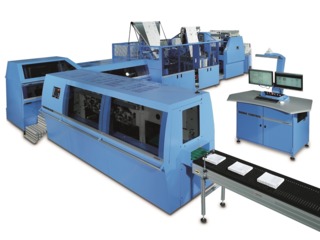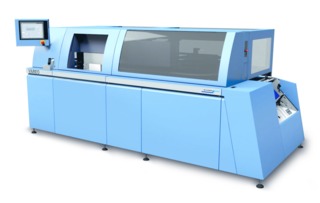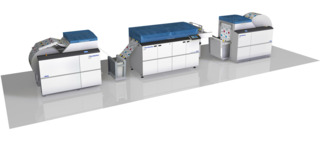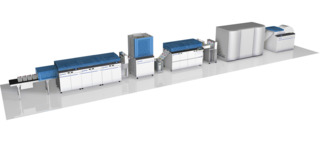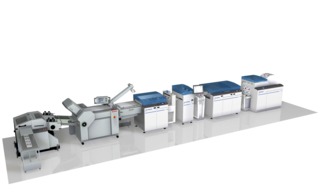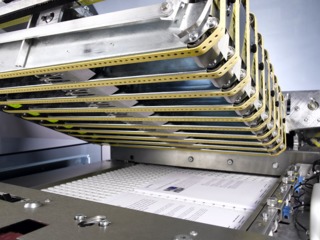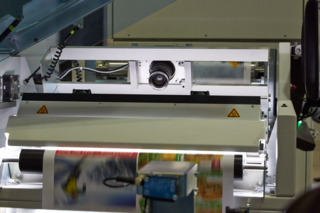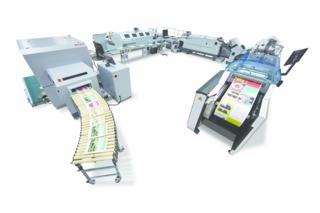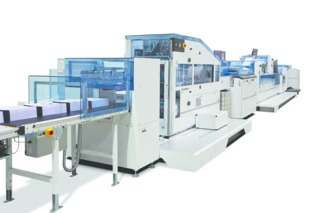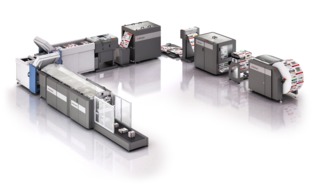High-Speed Postpress Production
New inkjet technologies require advanced finishing capabilities to keep up.
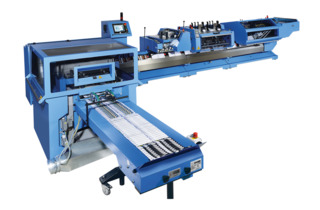
As almost every commercial printer knows, putting the ink on the substrate is not the end of the process. Before any printed piece can go out the door—be it a book, direct mail, postcard or any other product—it must first go through the finishing department. Whether it is cutting, folding, binding or some other type of postpress process, every piece is going to pass through that department before it can continue on to its final destination.
Many of today’s print service providers (PSPs) are transitioning from offset operations to offering high-speed production inkjet capabilities to the clients. And while these new presses and technologies open up a tremendous range of creative ideas for printed products, they also offer a challenge to the postpress side of the operation. Many shops are running legacy equipment designed for the output speeds and run lengths of offset presses, which is vastly different from the world of production inkjet.
Andy Fetherman, the director of digital solutions for Muller Martini Corp., noted that those using legacy equipment to finish their production inkjet work are doing themselves a disservice. “Predominantly, high speed inkjet users also purchase updated finishing to optimize makeready and take advantage of short turn-around times in the finishing department. Even with capacity from legacy equipment, people say they have it, and of course you can run jobs from digital presses on those machines, but the makereadys between jobs is offset like, which is not digital friendly. You water down the benefits of inkjet by finishing it on that legacy equipment.”
“Some adopters of inkjet employ legacy post-press equipment but for maximum efficiency, purpose-built, highly automated finishing solutions are gaining ground,” agreed Don Dubuque, director of marketing, Standard Finishing Systems.
He went on to note that PSPs need to take a hard look at what types of jobs they want to run—both now and in the future—and invest in the right postpress equipment to get there. “The PSP should do a complete inventory of current applications as well as anticipated work to fully comprehend which tools are needed. Critical to the selection process will be consideration of equipment that can handle the special requirements of roll-fed inkjet printing systems. Can the finishing solution keep up with the higher speeds of the chosen inkjet printer? Can white paper, produced in the print process, be automatically purged so that these powerful print engines run continuously, without costly stops and re-starts? Can they handle the range of substrates that will be processed by the inkjet printer? Are there special features to assure that image quality is not compromised, such as vacuum belts and special transport rollers which allow the printed material to be picked up and transported gently to avoid image scuffing? As more production inkjet presses have come to market, with broader substrate options, we see more technology being introduced to address the unique finishing requirements of inkjet.”
Flexibility is a key factor when choosing finishing equipment to compliment a high-speed production inkjet operation. The ability to adjust the equipment to handle multiple sizes, types and requirements quickly is key. “Unless your business is very narrowly focused, choose a flexible solution that will let you quickly transition from one job to the next. Twenty-first century customers want an on-demand print product tailored to their own particular needs, not an off-the-shelf solution, and they want it fast,” stressed Scott Peterson, Tecnau USA’s product marketing manager.
“Printers need equipment for today, with the ability to modify, or expand, as they grow into new markets and for the future,” agreed MBO America Director of Sales Lance Martin. “Modularity, variable data, variable finishing, automation, flexibility, web-fed and/or sheet-fed systems, glue systems, camera systems, water-scoring, and diecutting—all serve specific functions. In determining which capabilities could be implemented, carefully consider the type of work being done currently, and what you anticipate doing within the next 3-5 years.”
“The common thread for all of these printers is that they need to think about what is needed today and what they may need for tomorrow,” noted Nick Gerovac, director of sales & marketing for VITS International. “PSPs need to ask themselves ‘what are my customers going to want 1-3 years from now?’ Armed with this knowledge, the PSP then needs to work with their finishing suppliers to create a finishing solution that will meet their needs today, but be flexible enough to grow in the future. For example, if the PSP is running a 25-inch web today but is considering a 40-inch web in a year or two, investigate the cost of buying the 40-inch finishing line today. This will allow them to service their 25-inch web today and their 40-inch web in the future. A little more money spent today can save thousands in the future.”
Inline vs. Offline
When deciding to add to or upgrade existing postpress equipment to handle production inkjet capabilities, the first question a PSP needs to answer if they want inline or offline. The answer, again, depends on what type of work the shop is running now, and hopes to run in the future.
“An inline finishing solution combines a number of processes together in one integrated system, while offline finishing solutions require multiple steps and transfers from station to station to get to the final product,” explained Dubuque. “Every customer has different goals and pain points and there are benefits and penalties to each approach. Inline finishing removes manual touchpoints which reduces labor cost, but adds to system complexity. Operating offline, it’s a plus that press and finishing speeds can be dialed up or down as needed. Given inkjet’s unique ability to handle very lightweight substrates, you may want to finish slower than you print to obtain better quality. In other cases, the press may actually outrun the finisher and PSPs want to keep the printer running at maximum speed. Keep in mind, offline systems don’t depend on each other—if the press is down, the finisher can continue to produce and vice versa. On the flip side, offline finishing requires more manual touch points and more time, which increases labor costs and can decrease efficiency.”
“Usually it’s not so much the difference between inline and offline finishing equipment that would lead a PSP to invest in one over the other,” said Peterson. “Instead, a PSP must consider the tradeoffs between inline and offline processes. While an inline process certainly offers potential labor and throughput advantages, these benefits may be outweighed by a much lower investment required for an offline process. That lower investment can be achieved not because offline equipment is inherently cheaper, but because speed mismatches among the modules of an inline solution can dictate the purchase of more equipment than would be required in an offline environment. If the printer runs twice as fast as the finishing modules, you’re not going to want slow it down to accommodate finishing. A PSP should consider an inline solution if there’s a good speed match between the modules, but they should also consider that multiple inline modules are up and operating only as often as the least reliable module allows.”
Best Practices
For any PSP, there are a few universal things to keep in mind before investing in and running finishing equipment, be it inline or offline, legacy or new.
First, it’s all about the workflow. “What do they say in real estate – location, location, location. Well, in inkjet it’s workflow, workflow, workflow,” said Fetherman. “You can have the best finishing equipment and the best press, but if your workflow isn’t completely end-to-end from prepress to finished piece, it won’t be as good as it can be. There are many ways to do workflow, from JDF to barcode, but no matter what it is, workflow is by far the number one tip when managing finishing.”
Once the workflow is in place, it can’t be stressed enough that choosing the right equipment to grow with your shop is key to long-term success. “Start thinking about finishing when you are looking to purchase a press, and consult with finishing experts directly,” noted Martin. “This way, you have options available to you, specific to your own needs. Don’t let the print-salesman determine your finishing solution. You need not immediately purchase all solutions; you need solutions that can and will expand as you grow into new markets.”
And, finally, don’t limit yourself to equipment that can handle the types of jobs you do today. “When thinking about finishing, think outside the box. Don’t limit yourself to just the 20-inch, 25-inch or 40-inch web width of your press,” stressed Gerovac. “By going offline and running multiple webs into a common finishing line, the PSP can increase their throughput and decrease finishing time; direct mail printers now have more paper to allow for more creativity and trans-promo printers can insert more information into an envelope. Finishing is about being creative, offering new ideas to your customers and increasing your value proposition.”

